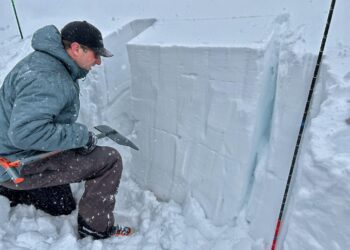By David Marston WRITERS ON THE RANGE

Moab, Utah, gets just 8 inches of rain per year, yet rainwater flooded John Weisheit’s basement last summer. Extremes are common in a desert: Rain and snow are rare, and a deluge can cause flooding.
Weisheit, 68, co-director of Living Rivers and a former Colorado River guide, has long warned the U.S. Bureau of Reclamation that its two biggest dams on the Colorado River could become useless because of prolonged drought.
Although recently, at a BuRec conference, he also warned that “atmospheric rivers” could overtop both dams, demolishing them and causing widespread flooding.
Weisheit points to BuRec research by Robert Swain in 2004, showing an 1884 spring runoff that delivered two years’ worth of Colorado River flows in just four months.
California well knows the damage that long, narrow corridors of water vapor—atmospheric rivers can do. Starting in December, one atmospheric storm followed another over the state, dumping water and snow on already saturated ground.
The multiple storms moved fast, sometimes over 60 mph, and they quickly dropped their load. Atmospheric rivers can carry water vapor equal to 27 Mississippi Rivers.
These storms happen every year, but what makes them feel new is their ferocity, which some scientists blame on climate change warming the oceans and heating the air to make more powerful storms.
In California, overwhelmed storm drains sent polluted water to the sea. Roads became waterways, sinkholes opened up to capture cars and their drivers, and houses flooded. At least 22 people died.
Where do these fast-moving storms come from? Mostly north and south of Hawaii, then they barrel directly towards California and into the central West, says F. Martin Ralph, who directs the Center for Western Weather and Water Extremes at Scripps Institution of Oceanography, UC San Diego.
“Forty percent of the snowpack in the upper Colorado in the winter is from atmospheric river storms penetrating that far inland,” he adds.
The real risk is when storms stack up as they did in California. That happened in spades during the winter of 1861-1862, in the middle of a decade-long drought, when the West endured 44 days of rain and wet snow. California Governor-elect Leland Stanford rowed to a soggy oath-of-office ceremony in flooded Sacramento, just before fleeing with state leaders to San Francisco.
Water covered California’s inland valley for three months, and paddle wheel steamers navigated over submerged farmlands and inland towns. The state went bankrupt, and its economy collapsed as mining and farming operations were bogged down, one quarter of livestock drowned or starved, and 4,000 people died.
In Utah that winter, John Doyle Lee chronicled the washing away of the town of Santa Clara along the tiny Santa Clara River near St. George. Buildings and farms floated away leaving only a single wall of a rock fort that townspeople had built on high ground.
Weisheit knows this history well because he’s been part of a team of “paleoflood” investigators, a group of scientists and river experts. To document just how high floodwaters rose in the past, researchers climb valley walls. The Journal of Hydrology says they seek “fine grained sediments, mainly sand.”
It’s a peculiar science, searching for sand bars and driftwood perched 60 feet above the river.
The Green River contributes roughly half the water that’s in the Lower Colorado River, and in 2005, Weisheit and other investigators found six flood sites along the Green River near Moab, Utah. Weisheit says several sites showed the river running at 275,000 cubic feet per second.
If the Green River merged with the Colorado River, also at flood, the Colorado River would carry almost five times more water than the 120,000 CFS that barreled into Glen Canyon Dam, some 160 miles below Moab, in 1984. That epic runoff nearly wiped out Glen Canyon Dam.
Now that we’ve remembered the damage that atmospheric river storms can do, Weisheit believes that Bureau of Reclamation must tear down Glen Canyon—now.
He likes to quote Western historian Patty Limerick, who told the Bureau of Reclamation, at a University of Utah conference in 2007, what she really thought: “The Bureau can only handle little droughts and little floods. When the big ones arrive, the system will fail.”
Dave Marston is the publisher of Writers on the Range, writersontherange.org, an independent nonprofit dedicated to spurring lively conversation about the West.











